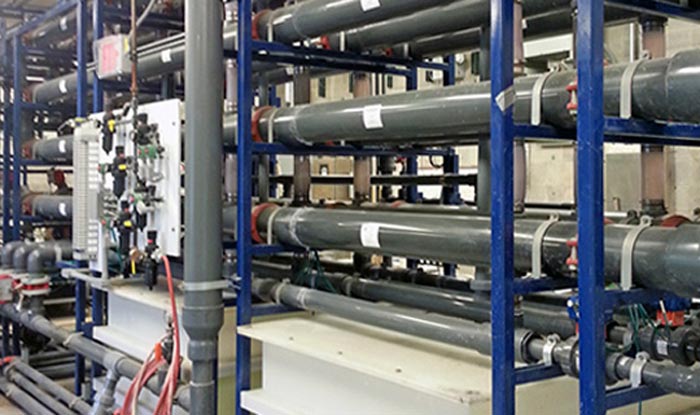Wastewater Recycling at a Steel Plating Mill
— Five Years Later

This large high speed strip steel plating mill had an aging conventional wastewater treatment system based on clarifier and DE leaf filter technology. Over the years it worked well for compliant discharge to an NPDES permitted outfall to the river. In 2010 it was time to replace it due to frequent breakdowns that began to impact production. Replacing a 350 to 500 GPM wastewater treatment plant with the same technology would have been one thing but replacing it with a water recycle technology was quite another. This also had to be accomplished while the mill continued to operate in compliance.
After evaluating all the potential industrial wastewater recycle technology options used in plating operations it became clear that tubular microfiltration followed by reverse osmosis (RO) had the best track record around the world for historical reliability. With over seven hundred installations worldwide membrane microfiltration had a proven track record going back forty years with many of the oldest systems still in service. Advances in polymeric membrane development have led to higher flux rates and improved solids separation dramatically improving the microfiltration as a pretreatment to Reverse Osmosis for industrial wastewater recycling.
A pilot study was conducted to confirm the efficacy of the concept on this plants wastewater. At that time both the tubular microfiltration and the Reverse Osmosis were piloted confirming the projected chemical protocol, the microfiltration flow over time, the cleanability of the membranes and the performance curves of the reverse osmosis. Metal removal efficiency was also confirmed for the microfilters as well as the RO brine metal concentrations for the NPDES discharge. The pilot results were outstanding and the decision was made to move forward with a phased-in installation.
The first phase was the installation of the crossflow microfiltration skids with a new two-stage reaction system. Performance was confirmed and approved before the next step.
Once the microfilters were started up and lined out, the existing clarifier could be converted to an equalization tank and the old reaction tanks could be converted to a feed system. The MF filtrate was compliant for discharge to the river. Then the DE Leaf filters could be removed to make space for the carbon filters and ROs.
The last stage was to install the RO system and confirm its performance prior to sending the water to reuse.
The original objectives were to:
- Replace the aged wastewater system with a more robust technology capable of reliably meeting their new, tighter NPDES limits.
- Improve the quality of their sludge to increase the value as a recycled resource and reduce the volume generated (by eliminating the diatomaceous earth from the leaf filters)
- Recycle as much of their wastewater as is cost effective reducing the city water purchased and improving the quality at the same time.
Not only did this system meet all of these objectives but it delivered the following additional benefits:
- The use of RO water reduced the frequency of boiler house Ion Exchange regenerations by 75% further reducing the salt load on the recycle system.
- Better quality rinse-water allowed for the reduction in use from 350 GPM to 250 GPM while providing better rinsing and improved quality.
- The new system has better controls, the operators are better educated and environmental liabilities are reduced.
Five years after start-up with over 100,000,000 gallons of water recycled, the system continues to recycle 80% of the wastewater using the original Microfiltration Modules and the original RO membranes. They continue to comfortably discharge the RO Brine to the NPDES discharge.

